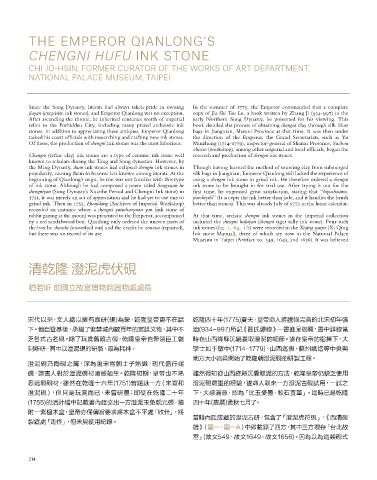Page 216 - Christie's Important Chinese Works of Art, May 31 to June 1, 2023 Hong Kong
P. 216
THE EMPEROR QIANLONG’S
CHENGNI HUFU INK STONE
CHI JO-HSIN, FORMER CURATOR OF THE WORKS OF ART DEPARTMENT,
NATIONAL PALACE MUSEUM, TAIPEI
Since the Song Dynasty, literati had always taken pride in owning In the summer of 1775, the Emperor commanded that a complete
jiayan (exquisite ink stones), and Emperor Qianlong was no exception. copy of Jia Shi Tan Lu, a book written by Zhang Ji (934-997) in the
After ascending the throne, he inherited centuries worth of imperial early Northern Song Dynasty, be presented for his viewing. This
relics in the Forbidden City, including many prized archaistic ink book detailed the process of obtaining chengni clay through silk filter
stones. In addition to appreciating these antiques, Emperor Qianlong bags in Jiangxian, Shanxi Province at that time. It was then under
tasked his court officials with researching and crafting new ink stones. the direction of the Emperor, the Grand Secretariats, such as Yu
Of these, the production of chengni ink stones was the most laborious. Minzhong (1714-1779), inspector-general of Shanxi Province, Suzhou
zhizao (workshop), among other imperial and local officials, began the
Chengni (refine clay) ink stones are a type of ceramic ink stone well research and production of chengni ink stones.
known to scholars during the Tang and Song dynasties. However, by
the Ming Dynasty, duan ink stones had eclipsed chengni ink stones in Though having learned the method of sourcing clay from submerged
popularity, causing them to become less known among literati. At the silk bags in Jiangxian, Emperor Qianlong still lacked the experience of
beginning of Qianlong’s reign, he too was not familiar with this type using a chengni ink stone to grind ink. He therefore ordered a chengni
of ink stone. Although he had composed a poem titled Songxuan he ink stone to be brought in for trial use. After trying it out for the
chengniyan (Song Dynasty’s Xuanhe Period and Chengni Ink stone) in first time, he expressed great satisfaction, stating that “biyushoumo,
1751, it was merely an act of appreciation and he had yet to use one to jiaoshiyibi” (It accepts the ink better than jade, and it handles the brush
grind ink. Then in 1755, Huojidang (Archives of Imperial Workshop) better than stones). This was already July of 1775 in the lunar calendar.
recorded an instance where a chengni yutuchaoyuan yan (ink stone of
rabbit gazing at the moon) was presented to the Emperor, accompanied At that time, archaic chengni ink stones in the imperial collection
by a red sandalwood box. Qianlong only ordered the uneven parts of included the chengni hufuyan (chengni tiger tally ink stone). Four such
the box be shoushi (smoothed out) and the cracks be zouzuo (repaired), ink stones (fig. 1, fig. 1A) were recorded in the Xiqing yanpo (Xi Qing
but there was no record of its use. Ink stone Manual), three of which are now in the National Palace
Museum in Taipei (Artifact no. 549, 1649, and 1656). It was believed
清乾隆 澄泥虎伏硯
嵇若昕 前國立故宮博物院器物處處長
宋代以來,文人總以擁有嘉研(硯)為榮,乾隆皇帝更不在話 乾隆四十年(1775)夏天,皇帝命人將謄錄完善的北宋初年張
下。他自登基後,承繼了紫禁城內數百年的宮廷文物,其中不 洎(934-997)所記《賈氏譚錄》一書進呈御覽,書中詳錄當
乏各式古名硯。除了玩賞舊藏古硯,乾隆皇帝也帶領臣工創 時在山西絳縣沉絹囊取澄泥的細節。遂在皇帝的指揮下,大
制新研,其中以澄泥硯的研製,最為耗神。 學士如于敏中(1714-1779)、山西巡撫、蘇州織造等中央與
地方大小官員開始了乾隆朝澄泥硯的研製工程。
澄泥硯乃陶硯之屬,深為唐宋兩朝士子熟識,明代盛行端
硯,讀書人對於澄泥硯材漸感陌生。乾隆初期,皇帝也不熟 雖然得知從山西絳縣沉囊取泥的方法,乾隆皇帝仍缺乏使用
悉這類硯材,雖然在乾隆十六年(1751)曾題詠一方〈宋宣和 澄泥硯磨墨的經驗,遂命人取來一方澄泥古硯試用,一試之
澄泥硯〉,但只是玩賞而已,未曾研墨;即使在乾隆二十年 下,大感滿意,認為「比玉受墨,較石宜筆」。這時已是乾隆
(1755)的活計檔中記載著內廷交出一方澄泥玉兔朝元硯,隨 四十年(農曆)孟秋七月了。
附一紫檀木盒,皇帝亦僅傳旨要求將木盒不平處「收什」,將
當時內廷庋藏的澄泥古研,包含了「澄泥虎符硯」,《西清硯
裂縫處「走作」,但未見使用紀錄。
譜》(圖一,圖一A)中即載錄了四方,其中三方現存「台北故
宮」(故文549、故文1649、故文1656)。因為以為這類硯式
214

